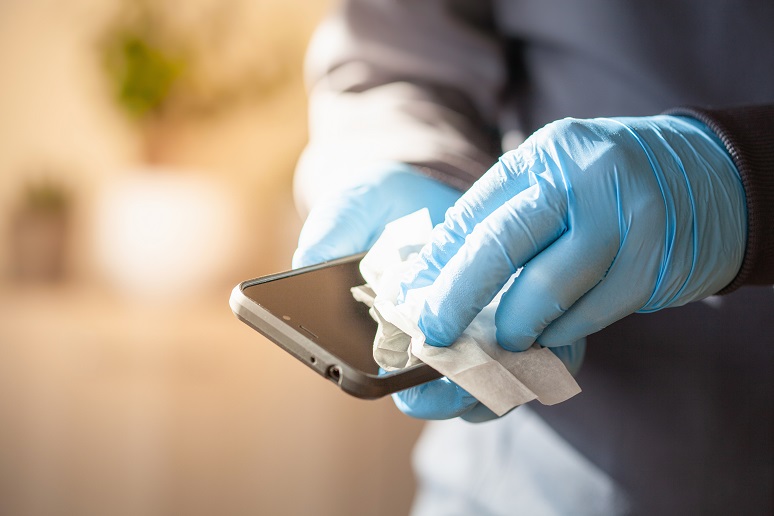From consumers to healthcare workers to retail and security associates, most of us carry mobile devices both for personal use and for work. In enterprise environments, many of these devices are shared among multiple coworkers, who may not follow the same strict handwashing procedures. In addition, phones are frequently set down on high-touch surfaces like tabletops and counters.
In the healthcare sector, in particular, mobile devices are used to call nurses, access patient health records, and enter data at patient bedsides. In warehouses, IT security, and retail environments, mobile devices may be shared by workers on different shifts throughout the workday. These devices harbor bacteria and can be a conductor for disease transmission if they aren’t properly sanitized.
Improperly disinfected phones are known to contribute to the risk of healthcare-associated infections and hospital-acquired infections (HAIs). One study from the
Annals of Clinical Microbiology and Antimicrobials, in 2009, screened 200 mobile phones from healthcare workers (HCWs) in 14 operating rooms and an intensive care unit (ICU). The results showed that 94.5 percent of the mobile phones demonstrated evidence of contamination with various pathogens.
COVID-19 has drawn increased attention to the need to sanitize mobile devices. Properly cleaning and disinfecting them is always important to prevent the spread of potentially harmful pathogens, not just during an outbreak of this scale. Microorganisms from workers’ hands can be transferred to the surfaces of the mobile phones during their use and then to other hard surfaces if they aren’t properly disinfected.
The Difference Between Cleaning and Disinfecting
Cleaning a phone with a microfiber cloth may produce the appearance of cleanliness, but in general, it’s not enough to remove harmful pathogens from the surface. The Center for Disease Control and Prevention (CDC) defines the differences between cleaning and disinfecting as follows:
Cleaning refers to the removal of germs, dirt, and impurities from surfaces. Cleaning does not kill germs, but by removing them, it lowers their numbers and the risk of spreading infection.
Disinfecting refers to using chemicals to kill germs on surfaces. This process does not necessarily clean dirty surfaces or remove germs, but by killing germs on a surface after cleaning, it can further lower the risk of spreading infection (CDC).
Ideally, mobile phones should be cleaned of visible impurities first, and then disinfected with a chemical cleaner or germicidal UV system. The following are four practical steps to properly cleaning and disinfecting phones.
- Choose the Appropriate Disinfectant Solutions for Infection Control - The type of chemical cleaner used will depend on the mobile device. For example, many consumer-grade devices won’t hold up to repeated disinfecting with harsh chemicals, and many don’t have the IP rating necessary to avoid the ingress of liquid that can damage internal device components. Check the manufacturer’s guidelines for what will work and not harm the device. However, some leading enterprise-grade devices are designed to hold up to frequent cleaning and disinfecting procedures. Common cleaning products for medical environments include, but aren’t limited to, hydrogen peroxide (3% solution), bleach (10% solution, not to be used on metal charging contacts), and isopropyl alcohol (91% solution). Furthermore, an important aspect to look for in enterprise-grade devices is an IP68 rating. These devices are tightly sealed to withstand dust ingress and unintentional submersion in water of up to one meter for as long as 30 minutes. There are many unknowns with COVID-19, including how long the virus remains viable on surfaces. The CDC currently recommends frequently disinfecting surfaces with EPA-registered disinfectants and household cleaners, including diluted bleach (1/3 cup of bleach per gallon of water) and alcohol solutions of at least 70 percent alcohol. Always follow the manufacturer’s instructions on the label to ensure safe and effective application (CDC).
- Establish a Regular Disinfecting Regimen - In addition to choosing the right chemical cleaners, it’s important to establish an appropriate cadence for cleaning and disinfecting phones. In many cases, it’s not enough to clean and disinfect once per day. The timing and frequency of cleanings will depend on where and how the mobile device is used. For example, phones used in hospital patient rooms or shared among various workers should be disinfected at a higher frequency compared to phones used in other locations or by only one person.
- Consider Ultraviolet Enclosures for Additional Safeguards- Germicidal ultraviolet (UV) systems can also be employed as an additional safeguard against HAIs. UV germicidal enclosures can deliver a kill rate greater than 99.99 percent for some of the toughest contaminants. Because of their effectiveness, UV boxes are an additional safeguard against HAIs and can fill the gaps in infection prevention protocols. Additionally, it’s important to make sure devices that are being used with UV systems have been tested for use with them to ensure that they don’t damage the plastics.
- Continue to Encourage Frequent Hand Washing - Every time workers pick up their phones, microorganisms from their hands can be transferred on to the surface of the device or other surfaces. Employees need to continue to maintain CDC guidelines for handwashing, including using both soap and water for at least 20 seconds (the time it takes to sing two “Happy Birthdays”), to help reduce the risk of harmful pathogens building up on the phone between device cleaning and disinfecting.
By performing these procedures step-by-step, individuals will not only protect their mobile devices from dust and dirt, they will also reduce the risk of contracting a disease.










